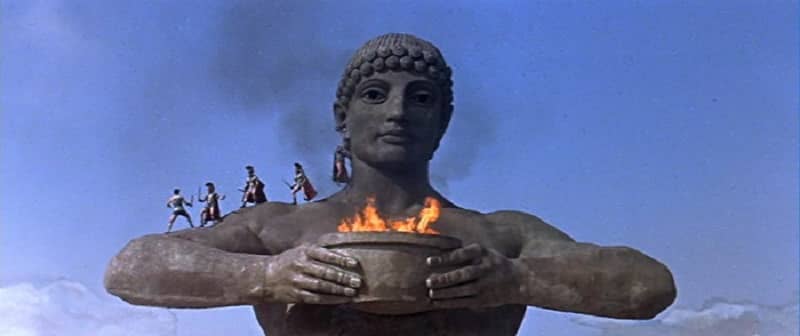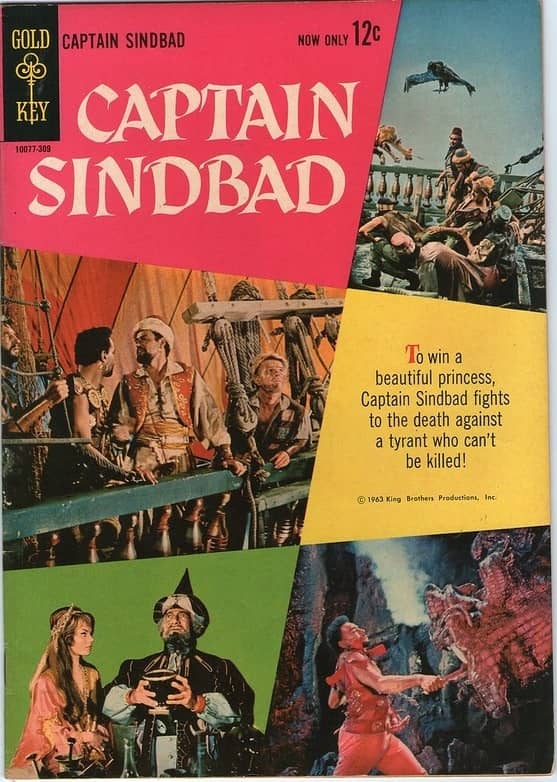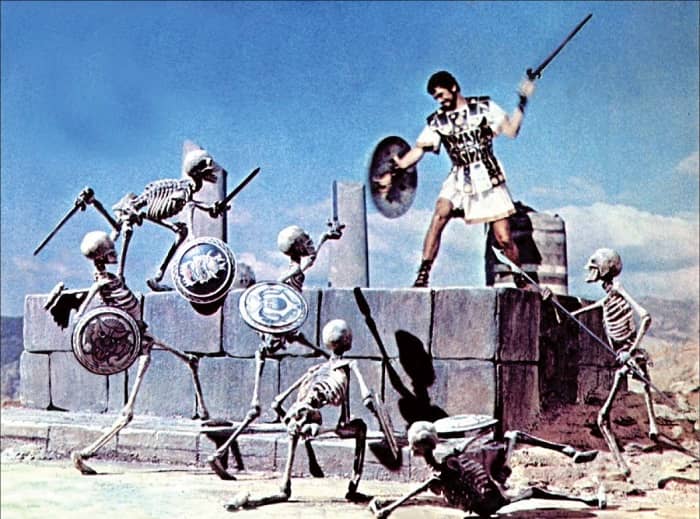Ellsworth’s Cinema of Swords: Mighty Colossi and Hydrae
The Colossus of Rhodes (Warner Bros, 1961)
It was a time of giants on the movie screen. In Japan, inspired by King Kong (1933) and The Beast from 20,000 Fathoms (1954), the kaiju, led by Godzilla, were wreaking swaths of destruction across the modern world. But by 1958, Ray Harryhausen, who’d animated The Beast, was looking backward to the ancient world, where the giants of myth had their origins, and other filmmakers in America and Europe were following the same path. Hissing hydras raised their many heads in tales of Jason and Sindbad, while Sergio Leone recreated the Colossus of Rhodes, and though he didn’t bring it to life, it was as much mechanism as statue. To see what it would be like if the colossus walked, we are indebted, once again, to Ray Harryhausen.
The Colossus of Rhodes
Rating: ****
Origin: Italy/Spain/France, 1961
Director: Sergio Leone
Source: Warner Bros. DVD
This is Sergio Leone’s first film as a director, and it’s mostly excellent. After working as assistant director on sword-and-sandal epics such as Quo Vadis (1951) and Ben-Hur (1959), Leone finally got to show what he could do as lead on this picture, which is probably the best-looking Italian historical epic of the peplum era. It has its drawbacks, though, particularly its questionable choice of lead in American cowboy star Rory Calhoun, who combines the glowering good looks of a Robert Mitchum with the leering insouciance of Dean Martin. An ancient Greek hero he ain’t. And, frankly, seven screenwriters is too many, even if one of them is Leone himself.
It’s 280 BCE, the Hellenistic period before the rise of Rome, and the Athenian war hero Darios (Calhoun) has arrived on the island of Rhodes on what he hopes will be a pleasure trip. Rhodes and its epicene King Serse (Roberto Camardiel) are celebrating the dedication of their spectacular new harbor defense, a 300-foot-tall bronze statue of Apollo that can dump flaming molten lead on attacking ships. Genius inventor Carete (Félix Fernández), who built the colossus, is the hero of the day, but Darios is more interested in pursuing his devious daughter Diala (Lea Massari). But politics gets in the way: the defenses of Rhodes were built by slave labor and the slaves are brewing a revolt, while the Phoenicians have promised to help Serse’s evil defense minister Thar (Conrado San Martín) usurp the throne in return for letting Phoenicia use Rhodes as a naval base against Greece. Everyone assumes Darios is a Greek agent, and he gets caught up in the intrigues. Darios, however, doesn’t want any part of local politics, but when he’s thrown into a lurid torture dungeon with the leaders of the slave revolt, he learns the basic peplum equation of rebels good, tyrants bad. (Also, Phoenicians bad, too.)
The problem is that Darios just isn’t very clever, and for two-thirds of the film he makes one poor choice after another, acting more like the hapless patsy in a Hitchcock thriller than a war hero who can tip the balance between the three factions. But Leone keeps things moving, interleaving scenes of his trademark tension and suspense with exciting action sequences in eye-popping settings, including a gruesome Temple of Baal (with a ballet of sacrifice!) and the interior of the colossus itself. Indeed, the colossus alone is worth the price of admission, a towering statue crammed with bronzepunk mechanisms, infernal devices, and royal guards in gorgeous Greco-Rhodian armor. When Darios, pursued by the gleaming guards, escapes out Apollo’s ear for a thrilling sword duel high atop the colossus’s biceps, you’ll think you’ve seen it all. And yet, you’re wrong!
So, Rory Calhoun notwithstanding, this movie wins on the basis of sheer spectacle, which thanks to Leone’s unerring eye is classy rather than cheesy. It is, dare I say it, colossal!
Captain Sindbad
Rating: ***
Origin: West Germany/USA, 1962
Director: Byron Haskin
Source: Warner Bros. DVD
What do you do if you want to make a Sinbad movie capitalizing on the success of 7th Voyage, but you’re not Columbia Pictures and you can’t get Ray Harryhausen to do the effects? First, you hire Byron Haskin as your director because he’s experienced with swashbucklers like Treasure Island (1950) and SF films chock-full of practical effects like From the Earth the Moon (1958). Second, for your Sinbad you hire Guy Williams, arguably the leading American swashbuckler star of the time coming off his run as Disney’s Zorro. Third, you add a letter to Sinbad’s name to cover your legal ass. And then, fourth: profit!
It’s worth pointing out that this film and Jason and the Argonauts, Harryhausen’s own follow-up to 7th Voyage, were released on the same day in June of 1963. Jason is maybe the finest fantasy film of the Sixties — but Captain Sindbad is not without its charms, and though nearly forgotten today, at the time it made just as much money as Harryhausen’s epic.
Unlike Jason, which is as serious as seven skeletons, Sindbad is a comic fantasy, an exuberant fable with a light touch for most of its running length. A lot of the gags seem flat and dated nowadays, but hang on, it’ll be worth it. The mythical Arabian-Nights style country of Baristan has been taken over by the wicked El Kerim (Pedro Armendáriz) — you can tell he’s bad because he has Evil Mustachios. El Kerim seeks to marry the dotty king’s daughter, Princess Jana (Heidi Brühl), to legitimize his usurpation of the throne, but Jana loves Sindbad, who is returning from a voyage of several years’ duration all unknowing of Jana’s plight.
The princess appeals to her “uncle,” the comic wizard Galgo (Abraham Sofaer), who transforms her into a firebird and sends her to warn Sindbad — but El Kerim gets wise and has Galgo change some of his guards into rocs, giant birds carrying boulders that sink Sindbad’s ship. However, Sindbad and most of his crew wash up safely in Baristan, where they plot to free the princess. Sindbad’s bold plan is to get himself captured and then confront El Kerim directly, which he does, running the villain through with a scimitar — to no effect, because his heart has been magically removed, making him invulnerable! Uh-oh.
It’s a rule that in every Sinbad movie the evil wizard gets the best part, and that’s certainly true here, as the mocking El Kerim has all the best lines, and also all the best outfits — is he a Persian, a Cossack, a Prussian, or a Mongol? The only person who’s better dressed is his leading henchman, Colonel Kabar (Henry Brandon), who has one of the finest black-goth villain suits ever. Anyway, Sindbad is captured and sentenced to The Arena to fight an invisible monster that’s right out of Forbidden Planet. But he swashbuckles an escape, pokes the goofy Galgo with a scimitar to make him talk, and learns that El Kerim’s heart is sequestered in an ancient tower on the other side of a haunted swamp. Main quest time!
Up to this point the film has been a light but uninspired romp with plentiful though unimpressive special effects, but now it gets good. Like, really good. The haunted swamp sequence is genuinely tense as Sindbad leads his crew through the mire and loses them, one by one, to strangler vines, sinkholes, crocodile puppets, boiling pools, and lava vents. And the ancient tower is even better. I won’t spoil the ending, but I will point out that the next-to-final boss monster is the clear inspiration for the Bigby’s Hand spells in Dungeons & Dragons. Plus, there’s a twelve-headed hydra, and that’s five more heads than on the hydra in Jason and the Argonauts. Take that, Harryhausen!
Jason and the Argonauts
Rating: ***** (Essential)
Origin: USA/UK, 1963
Director: Don Chaffey
Source: Viavision DVD
This is the finest fantasy film of the Sixties, and Ray Harryhausen’s favorite of all his features. We’ll get to why it’s so good at the end — but first, the basics. The story is adapted from Greek myth as told by Appolonios of Rhodes in the 3rd century BCE, a tale of prophecy, of fate, and of the interactions between gods and mortals. The hero Jason (Todd Armstrong), son of the slain King of Thessaly, wants to reclaim his throne, but more than that he wants to inspire his people to recover from the tyranny of King Pelias (Douglas Wilmer), so he decides on a grand quest to bring back a divine treasure, the Golden Fleece. He stages the first Olympic Games to attract Greece’s greatest athletes, the prize being a place with him in Greece’s greatest ship, the Argo. His final crew includes not only the demigod Hercules (the wonderful Nigel Green), but also Pelias’s son Acastus (Gary Raymond), who secretly plans to sabotage Jason’s quest.
Like the Odyssey, the journey of the Argo is a series of fantastic episodes, and like Odysseus, Jason is a hero of brains as well as brawn. The marquee attraction here, of course, is Harryhausen’s fabulous creatures, the harpies, the animated bronze statue Talos, the hydra, and the skeletons, but they’re joined by the more mundane pleasures of the Argo, a full-sized Greek galley, the natural settings of the coasts and isles of southern Italy, and the towering interiors of the temples of Hera in Thessaly and of Hecate in Colchis, their ancient splendor enhanced by masterful and magical lighting. Plus, the fight with the harpies is set in an actual ruined temple rather than a purpose-built set — for a fantasy, you can’t get realer than that!
So, what makes Jason and the Argonauts better than Harryhausen’s other epics, good as they are? I think there are at least four reasons why it takes the prize. First, the script by Beverly Cross and Jan Read is just smarter and sharper than that of any other Harryhausen fantasy, addressing what the Greeks felt they owed to their gods and what the gods owed to mortals in return. Jason’s character shows significant development, growing from an overconfident youth to a responsible leader. Second, this film is a career best for director Don Chaffey, who keeps tight control over the 80% of the film that doesn’t belong to Harryhausen, and even arts it up with interesting compositions and dynamic camera angles.
Third, the acting here is mostly quite good, both among both the humans mentioned above and the gods such as Honor Blackman as Hera and Niall MacGinnis as Zeus. In most Harryhausen epics, the performances of the human actors seem almost an afterthought, but that’s not the case here. Fourth and forever, there’s Harryhausen’s stop-motion animated creatures, always excellent, but these are among his best, especially the seven skeleton swordsmen in the climactic battle. The actors playing the Greek warriors work hard at it, but somehow, compared to the life and expressiveness of the warriors of animated bone, it’s the Greeks who seem like mere puppets. It’s an unparalleled work of artistic imagination, and you can’t see it too many times.
Where can I watch these movies? I’m glad you asked! Many movies and TV shows are available on disk in DVD or Blu-ray formats, but nowadays we live in a new world of streaming services, more every month it seems. However, it can be hard to find what content will stream in your location, since the market is evolving and global services are a patchwork quilt of rights and availability. I recommend JustWatch.com, a search engine that scans streaming services to find the title of your choice. Give it a try. And if you have a better alternative, let us know.
The previous installments in the Cinema of Swords include:
The 7th Voyage and Its Children
The Good, the Bad, and Mifune
The First British Invasion
Wholesome Buccaneers (Pt. 1)
The Tale of Zatoichi
The Sign of the Z!
Gallic Gallantry
Classic, Mythic and Epic
The Exuberant Excess of Sixties Vikings
Tyrone’s Typecast Troubles
Not-So-Wholesome Buccaneers
Daimajin Strikes Again!
Three Counts of Monte Cristo
Mongols, Cossacks, And Tartars
I Heard You Like Swords
Bard’s Tales
Hu’s on First
Flynn’s Last Flourishes
LAWRENCE ELLSWORTH is deep in his current mega-project, editing and translating new, contemporary English editions of all the works in Alexandre Dumas’s Musketeers Cycle, with the fifth volume, Between Two Kings, coming in July from Pegasus Books in the US and UK. His website is Swashbucklingadventure.net.
Ellsworth’s secret identity is game designer LAWRENCE SCHICK, who’s been designing role-playing games since the 1970s. He now lives in Dublin, Ireland, where he’s writing Dungeons & Dragons scenarios for Larian Studios’ Baldur’s Gate 3.



Sword and Sandals movies – what’s not to love?
What? Another episode of Cinema of Swords??? Oh, Thank God!
Until I hit 18 years of age, any list of my top 10 favorite films would have included these three movies. I just thought they were great, even Captain Sindbad, and I could watch them over and over again. I haven’t seen the first two in decades, but I recently re-watched Jason and the Argonauts and it more than holds its own with any recent movie. Ave, Harryhausen!
I heartily endorse your ratings for these three classics, and yes, The Colossus of Rhodes WAS colossal.
Thanks for another great post!
Nigel Green is one of the best on-screen Hercules. His virility and overall exuberant personality eclipses the more muscular, but far less interesting Steve Reeves.
Jason is a classic of the first water and Colossus is a lot of fun. I’ll have to revisit Captain Sinbad at some point — when I previously watched it, I knew it wasn’t going to be Harryhausen, but I was at least expecting something more like Thief of Bagdad or Sinbad the Sailor; maybe if I recalibrate my expectations I can enjoy it more.
So many Saturday afternoons in my youth spent watching these kinds of movies on the fancy new cable, how is it that JatA is the only one of these three I’ve seen? (Loved that skeleton fight!)